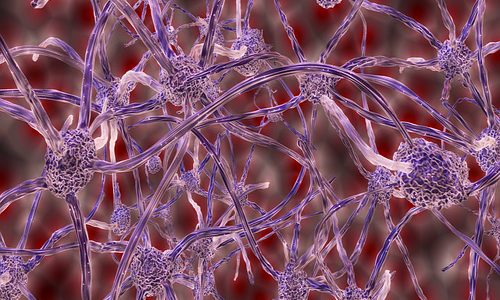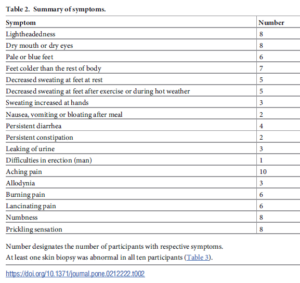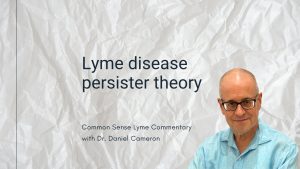Call for your appointment today 914-666-4665 | Mt. Kisco, New York

The retrospective study included 10 patients diagnosed with post-treatment Lyme disease syndrome, who had autonomic testing performed between 2016 and 2018 at the Brigham and Women’s Faulkner Hospital Autonomic laboratory. [1]
The authors aimed to identify SFN as a possible biomarker of “PTLDS,” in addition to evaluating autonomic dysfunction associated with presumed small fiber neuropathy and assessing cerebral blood flow, since cognitive complaints may be due to cerebral hypoperfusion.
Novak and colleagues defined “PTLDS” using the Aucott’s criteria, which states that patients must have:
- A combination of fatigue, cognitive complaints and chronic widespread pain following the treatment of Lyme disease for at least a 6-months period;
- An absence of other disorders that can explain the complaints associated with “PTLDS”;
- A documented history of Lyme disease satisfying the CDC criteria.
Their 10 patients presented with a broad range of symptoms. The most common included lightheadedness (n=8), dry mouth or dry eyes (n=8), pale or blue feet (n=6), feet colder than the rest of the body (n=6), decreased sweating at feet at rest (n=5), and decreased sweating at feet after exercise or during hot weather (n=5).

Pain was frequently reported and described as: aching pain (n=10), numbness (n=8), prickling sensation (n=8), burning pain (8), lancinating pain (6), and allodynia (n=6). (Allodynia refers to central pain sensitization following a normally non-painful stimulation.)
Less common symptoms were: sweating increased at hands (n=3), nausea, vomiting, or bloating after meal (n=2), persistent diarrhea (n=4), leaking of urine (n=3), persistent constipation (n=2), and difficulty in erection (n=1).
All of the subjects had previously undergone routine autonomic testing. Novak and colleagues performed skin biopsies from the right calf using a 3-mm circular disposable punch tool.
They found that more than 50% (7 out of 10) of patients had a low cerebral blood flow velocity (CBFv) from their middle cerebral artery. This was determined using a Transcranial Doppler. The study was not designed to determine if the low CBFv contributed to the cognitive impairment in those 7 patients.
All of the patients had a loss of small fibers, along with autonomic dysfunction and abnormal cerebral blood flow.
[bctt tweet=”Sensory symptoms and pain reported by some patients with ongoing Lyme disease symptoms may be caused by small fiber neuropathy and a low cerebral blood volume, according to the authors of a new study.” username=”DrDanielCameron”]
According to Novak, the sensory symptoms and pain reported by their patients may have been caused by small fiber neuropathy and low cerebral blood volume. “SFN appears to be associated with ‘PTLDS’ and may be responsible for certain sensory symptoms,” the authors write. “Dysautonomia related to SFN and abnormal CBFv also seem to be linked to ‘PTLDS’.”
Therefore, “Our study indicates that SFN may be an objective marker of ‘PTLDS’, at least in patients with prominent sensory symptoms,” Novak writes.
The study was not designed to address treatment. The authors assumed the patients did not have a persistent infection.
Editor’s note: I have been reluctant to use the term “PTLDS” until there is a reliable test to rule out a persistent infection.
Related Articles:
Can we measure the brain’s exaggerated response to pain and sensory input?
Is your fibromyalgia patient a candidate for Lyme disease treatment?
References:
- Novak P, Felsenstein D, Mao C, Octavien NR, Zubcevik N (2019) Association of small fiber neuropathy and post treatment Lyme disease syndrome. PLoS ONE 14(2): e0212222. https://doi.org/10.1371/journal.pone.0212222




Lyme is real! We need treatments that work. We need people to take us seriously.
Marker? you gotta be kidding me. What about systemic autoimmune diseases like Sjogren’s that cause SFN (and evven POTS) in youth without sicca and without positive antibodies,…how can SFN be a marker for Lyme.
That is the problem with any biomarker. Small fiber neuropathy can be seen in Lyme disease but may reflect the effects on the immune system. Other illnesses also affect the immune system. POTS is seen in Lyme disease through its effect on the autonomic nervous system. POTS can also have more than one cause.
Then I guess I have the definition of ‘marker’ wrong. I thought it means you have that specific disease.
Biomarkers offer clues for the disease or how active the disease is. They are often not diagnostic on their own.
I have for as long as I remember some kind of PANS, and dysautonomia (heat sensations in my feet, soon neuropathies), then from puberty prob POTS, Hashimoto too. My Lyme diagnosis was clinical, based on high positive Elispot/LTT, but only p83 on Western blot. I never had antibiotics for 20+ years of being symptomatic. Until 5 years ago when I had massive herx from just doxy, azithromycin, monotherapy. The herxing following 2 years made POTS worse and my ANA turned positive, with weak positive SSA. My POTS antibodoies (adrenergic and muscarinic receptors) were record high /700% increased../. I have family history of Sjogrens. Even though antibiotics got rid of many sympotms (facial neuropathy, some neuropsychiatric), seems like they further enhanced autoimmune component and in the end I got even Sjogren’s with classical sicca part. …… What baffles me is that research on Sjogren’s antibodies (early Sjo ) says 41% of POTS patients who have dryness but negative ANA/sjogrens (mind you, I was in the group without dryness!!!) has early Sjo antibodies,, so almost half patient with POTS if you count in those with official Sjogrens/lupus. At the same time I hear ILADS doctors saying that 50% of Lyme patients have POTS. Seems like neuro-Sjogrens, without sicca, often present in youth, is almost undistiguishable from Lyme. Another interesting thing that nobody speaks about is if 50% of Lyme patients have POTS, and 90% of POTS patients have alpha1 adrenergic (and some muscarinic) antibodies, would that mean there is strong connection of Lyme with adrenergic antibodies. As they recently published 1st appear Adrenergic in POTS, and later patients get muscarinic too (Sjogrens), and seems like that is how it was in me, 20 years of POTS and only then Sjogren’s. Dr Cameron, how often you see ANA test or even specific antibodies for lupus or Sjogrens, go negative from Lyme treatment? I am unsure if i should continue in that direction because I think antibiotics wreaked my gut, 2 years ago Rocephine caused severe damage to gut and then to brain too, and I got more neuroinflammation, still recovering 2 yrs later, I think it was leaky gut.
POTS is common in Lyme disease. I am sure the percentage. Rheumatologic diseases and Lyme disease overlap, in part, because they are both driven by an overactive immune status. We are only scratching the surface on what happens to the immune system during a tick-borne infection.
Dr. Cameron ,
Have you observed erratic blood pressure, with orthostatic hypertension, in your Lyme patients ? If so, has antibiotic treatment resolved this complex issue ?
Can POTS be reversed when the Lyme and Co Infections are treated? If Lyme & Co infections are the underlying condition?
I find POTS can be a frustrating part of Lyme disease and can be difficult to treat. I find treatment for Lyme along with POTS treatment quite helpful.
How do you go about diagnosing and treating SFN in post Lyme Disease treatment disorder?
I rely on a neurologist to diagnosed SFN. I am not always sure what the cause of SFN is. I have had patients in my practice with presumed PSLDS with SFN who have improved with antibiotics. You have to work with your doctor or doctors.
My SFN never went away with treatment
I have patients who have failed treatment with IVIG. I have patients improved by changing up their antibiotic schedule. I also advise my a patients to followup with a neurologist.
I have changed several antibiotics (doxycycline, minocycline, bactrim, rifampin) over 7 months. My condition got even worse, I kept worsening and my biopsy showed severe damage so I was put on IVIG.
I also have treatment failures in my practice. I lean on the neurologist for these cases. I also have some patients who have benefited from treatment for Babesia.
How do I follow up with neurologists when they don’t believe in Lyme Disease ? I am in severe pain 24/7 for three years and not one Doctor has helped me. I can not explain the pain I am in each day. It is inhumane and it has crippled me in just a few years. They laugh in my face, they downplay my pain. Pain Management says there is nothing wrong with me and refuse to treat my pain. I wish you all could be in my body just for one day. You all would cry like babies.
I have patients in severe pain despite everything their neurologist and pain management can offer. Some of them improve if their Lyme disease is treated. I also have patients who reports some gains under the care of a neurologist when prescribed IVIG. I also have patients who have found ketamine helpful.
Hi Joe,
I am sorry that you are going through this pain. I have been in pain for 3 years. I also had numbness, tingling, cold feet, spasmed muscles in my neck and left leg. I have done all sort’s of treatments with no change. Doctors did not believe me and many said that it is in my head.
6 months ago I went to Lyme Naturopathic doctor who did Igenex Lyme test which finally showed that I have Lyme. I also did skin/muscle/nerve biopsy which showed small fiber neuropathy. I treated Lyme with 3 different antibiotics 3 times a day for three months. My paid decreased from 10 to 6 but I had many bad side effects from antibiotics. Then I tried 2 weeks of IV antibiotics every day which my body handled better. After that I started taking herbal antimicrobals, antifungul, immunes support, vitamins… I am taking about 20-30 pills (herbs, Chinese medicine, vitamins). I am also doing hydro peroxide and high dose vitamin C IVs once a week. My pain level is down to 3-4 now.
All 5 neurologists that I visited with SFN issue still say that Lyme does not exist in Oregon and that it is in my head. Please don’t give up and keep looking for a right doctor. Try naturopath with Lyme experience.
How is the IVIG going? I too have SFPN for 5 + years. Out out my many symptoms my #1 issue are all day headaches.
I have been trying to get IVIG since I was diagnosed Idiopathic in 2020 from famous NYC Hospital. I was tested negative for Limes 3 times. I also was tested for just about everything else possible including Genetic testing. So finally after not getting a Dr to prescribe IVIG w/o a cause I ordered did my own lab work art Vibrant America Labs (my dietitian was the provider) it came back 3 weeks ago positive for Lyme disease “a bad case” . I just started antibiotics this week. So I really hope that IVIG is working for your symptoms and like to know more about your experience with it.
Do you think babesia only could cause sfn?
I have had patients with small fiber neuropathy (SFN) that have improved with treatment for Babesia.
How do I find treatment as thorough as you do here in Ohio? Or should I travel in these Covid Times?
My Hudson Valley tick bite with EM 26 years ago, misdiagnosed as bipolar illness. IGenX positive for bartonella at year 21 and some, but not enough bands for burgdorfi through care with a naturopath. Bartonella Sjgroens, POTS, neuropathy, neurological are all taking their course, despite continued nutritional and herbal anti viral support.
I am so tired of trying to get adequate antibiotic treatment again, having to put up with the MDs who are in need of continuing education on this. I could even help design the curriculum and train the trainers if I wasn’t so darn sick and tired of being so sick and tired. And the neuropathy is making it difficult to play my fiddle!
I would keep looking. It is always better if you find someone in your area to facilitate treatment if needed. I always advise my patients to include other specialists at the same time for POTS and neuropathy to avoid missing another diagnosis.
Please send me the web addresses for any studies And/Or antidotal information from doctors or researchers on Small Fiber Neuropathy AND Chronic aka Post Treatment Lyme Disease?
Thank you for your time and consideration.
DA Vietnam Veteran
Any links to articles or audio/videos on agent orange and SFN would be appreciated? Please keep my information private.
That is tall order. You might find my blogs on the subject on the search bar of my website at https://danielcameronmd.com/. The web including Pubmed may help. I advise my patients to include a neurologist.
Is Lyme disease associated with Eczema?